Brief Summary
Two years ago Evinrude introduced a pair of new engines that were designed to hit the mid-horsepower range of the outboard market which was primarily fishing boats. The new engines were specifically designed for boaters who wanted to repower, but didn’t want the initial expense of a 150-hp engine. The new engines were also intended to address new boat sales in the 16’ to 23’ range where 40% of all outboard boats are sold. The resulting products were the Evinrude 130 H.P. and 115HO V-4 E-TEC 2-stroke engines.
But the timing of the introduction of these two new engines couldn’t have been worse, thanks the world economic meltdown and resulting recession during the 2008-09 seasons. But now, as the world’s economies slowly climb back toward normality, and boaters move their new-boat buying and repower plans to the front burner, it is time to once again take a look at these two powerful, mid-range engines.
The Evinrude E-TEC 130 H.P. is available in four different types
Key Features
- No Maintenance for 3 years / 300 hours No inspections or adjustments, no changing gearcase lube, no spring tune-ups.
- Fewer parts 195 fewer than a four-stroke. No valves, belts, camshafts or pulleys to adjust or replace.
- No oil changes A four-stroke gets one every six months or 100 hours – 60 if you’re doing heavy trolling.
- 3-year, 300-hour spark plugs Advanced iridium plugs – featuring a longer, more efficient spark.
- Auto storage The engine fogs itself automatically in minutes, with no trip to the dealer. So easy, you can do it any time.
- Instant throttle response Not just select points. The key is that every revolution is a power stroke. That means twice the power strokes of a four stroke.
- Less fuel The engine management system makes more than 8 million calculations per second. You get the precise amount of fuel you need at any given rpm.
- High torque The natural two-stroke advantage combined with our super-natural fuel-injection and combustion system.
- Bigger alternators Nearly twice the available amperage of competitive engines. Run more accessories with more confidence.
Specifications
| Type of Engine | 2-Stroke |
|---|---|
| Number of Cylinders | 4 |
| Horse Power | 130 |
| Configuration | |
| Weight | 390.00lbs |
| Fuel Type | Gasoline |
| Fuel Delivery | |
| Shaft Length Options | 20 in for DSL,DPL / 25 in for DPX,DCX |
| Shift Throttle Control | |
| Displacement | 105.40cu in |
| Steering Control | Power Assist |
| Recommended Fuel | 87 Octane |
| Alternator Output | |
| CARB Rating | 3-Star |
| Engine Monitoring System |
Captain's Report
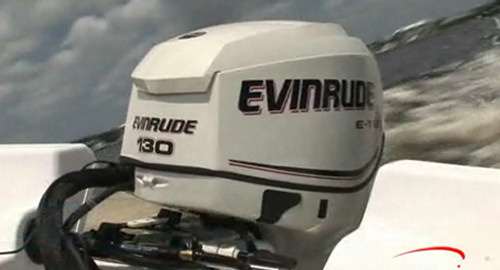 We tested the E-TEC 130-HP on a Carolina Skiff DLV 218 Elite with a test weight of just over 3300 lbs. (1497 kg).
We tested the E-TEC 130-HP on a Carolina Skiff DLV 218 Elite with a test weight of just over 3300 lbs. (1497 kg).Overview
Boaters considering repowering must carefully consider what they are doing. Until the last 10 to 15 years or so, boats were designed for the weight of 2-stroke outboards. Putting a heavier 4-stroke engine on an older boat designed for a lighter engine is likely to move the boat’s CG aft and harm performance. And while the 4-stroke units have been around for quite some time there are still many boats on the market that were designed for 2-stroke power (and weight).
Alternatively, the Evinrude 130-hp engine provides engine redundancy option for boaters thinking about repowering with a single 250-hp outboard. Because of the dramatic improvement in fuel economy of the new generation of E-TEC Evinrude engines over the old 2-stroke technologies of all the brands, Evinrude E-TEC engines are on virtually everyone’s short list of outboard models when considering repowering these days.
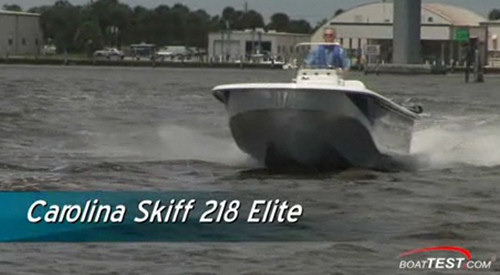 We tested the Carolina Skiff 218 Elite with the Evinrude 130 in calm waters. Note the bottom shape which provided some relatively flat running surfaces.
We tested the Carolina Skiff 218 Elite with the Evinrude 130 in calm waters. Note the bottom shape which provided some relatively flat running surfaces.Weight Matters
Because this Evinrude 2-stroke engine has over 190-fewer parts than most 4-stroke outboards, it is easy for any 2-stroke engine to be lighter. But in the case of the E-TEC 130 model, the weight difference is striking – the Evinrude 130 is lighter than all of them, because there aren’t any others! This important “sweet spot” has been left uncovered by the two biggest engine makers. They let their 150-hp models cover this important range. So for Evinrude, it’s easy for the ‘Rude 130 to be lighter than the 150s by from anywhere from 93 lbs. (42.27 kgs.) to 135 lbs. 61.36 kgs.)
Cascading Benefits
That one important product detail – less weight -- cascades into a whole series of advantages for the Evinrude 130 engines – higher top speed and more fuel efficiency (all things being equal), to say nothing of fewer parts to break or wear out, and therefore lower maintenance requirements.
Because the Evinrude E-TEC engines are 2-stroke they have twice as many power strokes than do 4-stroke engines and that, along with the gear ratio in the 130 20”-shaft units of 2.00:1 gives these engines tremendous torque to the prop. In fact, they have a reputation for having “a lot of bottom-end grunt,” says one prop expert, even when over-propped. This translates into fast hole-shots for fishermen and an easier start-up for skiers. In our tests, the 130 had our 3300 lb. (1497 kg.) test boat on plane in only 4.5 seconds, and passing 30 MPH in 11 seconds.
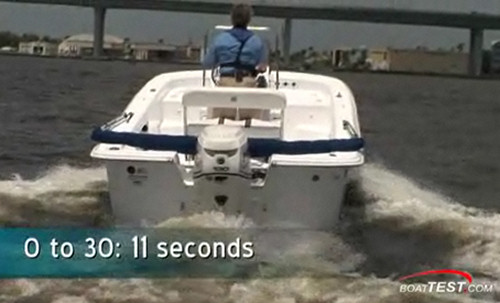 The 218 Elite weighed 3300 lbs. (1497 kgs.) which is not light for this size and type of boat.
The 218 Elite weighed 3300 lbs. (1497 kgs.) which is not light for this size and type of boat.Interesting Performance Feature
At around 4,000 RPMs the tuned exhaust of the E-TEC 130 engine opens a valve to retune the exhaust (by reducing back pressure), resulting in another burst of speed. This phenomenon was experienced on our recent test and we have captured it on video. Evinrude says that its tuned exhaust system “brings alive” the engine and is worth another 10 horsepower.
Operating Expense
While the Evinrude 130-hp engine will not push a boat as fast as a 150, neither will it burn as much fuel. Evinrude claims that typically their 130-hp engine will burn 12 gph at WOT, compared with 16 gph on the same boat at WOT with a 150-hp engine. Since our test showed this 12GPH number to be true, then that is a whopping 25% fuel savings in exchange for five to seven mph less in top-end speed. That is a trade-off that many boaters will consider.
Perhaps the most dramatic difference in operating expense of the Evinrude 2-stroke engines over 4-strokes is its required maintenance schedule. There is no break-in period required for Evinrude E-TEC motors and the first dealer-scheduled maintenance does not come until 3 years or 300 hours of operation has been reached. Then, after that, dealer maintenance is not required for another 3 years or 300 engine hours.
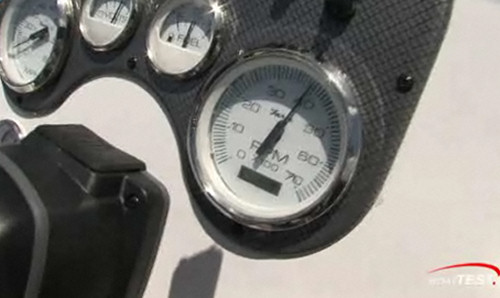 It is at 4000 rpm that the tuned exhaust opens up, providing what Evinrude engineers say is another 10 horse power. Capt. Steve said the power surge was noticeable.
It is at 4000 rpm that the tuned exhaust opens up, providing what Evinrude engineers say is another 10 horse power. Capt. Steve said the power surge was noticeable.Warranty
Because Evinrude has such faith in its product, it has a standard 3-year warranty, which is “non-declining.” That means that the engine value, and the value of its parts, are not reduced over the 300 hours by the number of hours used if there is a warranty issue. During certain promotions we have seen Evinrude’s warranty period is even longer.
Test Results
We tested the Evinrude E-TEC 130 -hp in a Carolina Skiff with a test weight of 3300 lbs. (1497 kg). Our top speed was 38.4 MPH reached at 5550 rpm. This translated into a fuel burn of 12 gph or 3.2 mpg.
Best cruise can be divided into two categories. Best speed and best economy. At 3500 rpm the speed was an even 20 MPH, with a fuel burn of 5 gph or 4 mpg. But at 4000 rpm the speed bumped up to 25.6 MPH while fuel went to 6.3 gph and 4.03 mpg. The bottom line is the range only differed between the two by 2 miles; 180 miles for 3500 rpm and 182 miles for 4000 rpm.

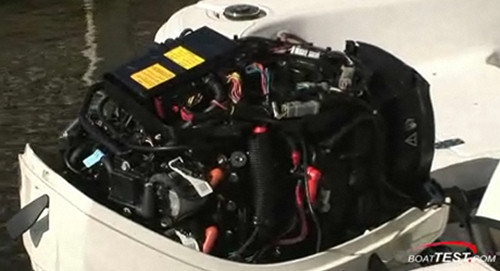 The Evinrude 130's black box which can be seen on the top of the engine is water cooled for peak performance and longer life.
The Evinrude 130's black box which can be seen on the top of the engine is water cooled for peak performance and longer life.Recommendation
The Evinrude 130-hp E-TEC offers the consumer a positive alternative to 4-stroke power. Further, there is nothing on the market in its power range, so if you don't need 150 horses, why pay for them in the first place? But the largest consideration is the cost of Evinrude's maintenance schedule compared to those of the 4-stroke brands. With the competitive fuel consumption figures shown above, the 'Rude's cost of overall operation is hard to beat.